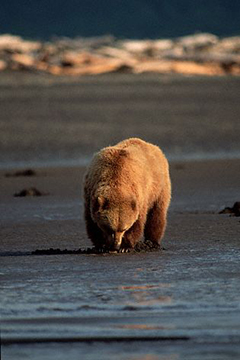|
Embracing nearly a million acres of old growth rainforest, alpine tundra, and rugged coastline, Admiralty Island National Monument has been home to the Tlingít people for centuries and to the brown bear even longer. The Tlingít call this island Kootznoowoo - the Fortress of the Bear - and their name is accurate.The 956,155-acre monument is home to an estimated 1,600 brown bears, the highest concentration anywhere in the world and more brown bears than the rest of the states combined. The island also has the world's greatest concentration of nesting bald eagles. More than 5,000 eagles live on Admiralty Island and average a nest every mile along the coastline of Seymour Canal. Admiralty Island has a variety of other wildlife as well. Bays such as Mitchell, Hood, Whitewater and Chaik contain harbor seals, porpoises and sea lions. Humpback whales can often be spotted feeding in Seymour Canal. Sitka black-tailed deer are plentiful, and the streams choke with all five species of Pacific salmon that spawn in July and August. Located 15 miles southwest of Juneau, Admiralty Island is bounded on the east and north by Stephens Passage, on the west by Chatham Strait and on the south by Frederick Sound. Admiralty is a rugged island, with mountains that rise to 4,650 feet and covered by tundra and even permanent icefields. Numerous lakes, rivers and open areas of muskeg break up the coastal rain forest of Sitka spruce and western hemlock. More than 90 percent of the monument is designated as the Kootznoowoo Wilderness while the lone community is Angoon, a predominantly Tlingit village at the mouth of Mitchell Bay on the west side of the island. |
GBM#05 Pack Creek Bear Viewing at Waterfall Creek
Tour Itinerary
Dates | Rates
Glacier Bay National Park FAQ
|
Day
01 |
 |
Fortress of the Bears - Waterfall Creek Brown Bear Viewing at Waterfall Creek: After landing, disembark from the floatplane and wave goodbye to the Alaskan bush pilot. The primary viewing spot is a short walk down the rocky shoreline. Follow the sounds of the waterfall and splashing salmon, as the guide hikes the Brown bears may be seen at any time while ashore. The guide will direct to the best spots for viewing and photography. Groups will spend most time seated, quiet, and still to enhance the opportunities of seeing bears. While we do occasionally have close encounters, our goal is for the bears to ignore us and engage in their natural behaviors. |
| Rates in US $ / per Person | Adult |
| Pack Creek Bear Viewing Package (11 AM - 7 PM) | $ 1020.00 |
|
 |
|||||||||||||||||||||||||||||||||||||||||||||||||||
Glacier BayNational Park - FAQ
|
|||||||||||||||||||||||||||||||||||||||||||||||||||